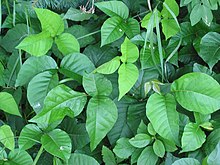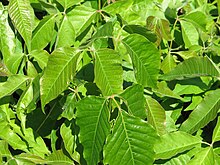Toxicodendron
| Toxicodendron | |
|---|---|

| |

| |
| Two pictures of Toxicodendron radicans | |
| Scientific classification | |
| Kingdom: | Plantae |
| Clade: | Tracheophytes |
| Clade: | Angiosperms |
| Clade: | Eudicots |
| Clade: | Rosids |
| Order: | Sapindales |
| Family: | Anacardiaceae |
| Subfamily: | Anacardioideae |
| Genus: | Toxicodendron Mill.[1] |
| Species | |
|
See text | |
Toxicodendron is a genus of
lacquer tree. All members of the genus produce the skin-irritating oil urushiol, which can cause a severe allergic reaction. The generic name is derived from the Greek words τοξικός (toxikos), meaning "poison," and δένδρον (dendron), meaning "tree".[2] The best known members of the genus in North America are poison ivy (T. radicans), practically ubiquitous throughout most of eastern North America, and western poison oak (T. diversilobum
), similarly ubiquitous throughout much of the western part of the continent.
The genus is a member of the Rhus complex, and has at various times been categorized as being either its own genus or a sub-genus of Rhus.[3] There is evidence which points to keeping Toxicodendron as a separate monophyletic genus, but researchers have stated that the Toxicodendron and Rhus groups are complex and require more study to be fully understood.[4]
Plants in the genus have
pinnately compound, alternate leaves and whitish or grayish drupes. They are quite variable in appearance. The leaves may have smooth, toothed, or lobed edges, and all three types of leaf edges may be present in a single plant. The plants grow as creeping vines, climbing vines, shrubs, or, in the case of lacquer tree (T. vernicifluum) and poison sumac (T. vernix
), as trees. While leaves of poison ivy and poison oaks usually have three leaflets, sometimes there are five or, occasionally, even seven leaflets. Leaves of poison sumac have 7–13 leaflets, and of Lacquer Tree, 7–19 leaflets.
The common names come from similar appearances to other species that are not closely related and to the allergic response to the urushiol. Poison oak is not an
ivy (Hedera, family Araliaceae), but has a superficially similar growth form. Technically, the plants do not contain a poison; they contain a potent allergen
.
The
manufacture, their berries are used to make japan wax
.
Candlewax
In
olein with about 1% japanic acid (1,21-heneicosanedioic acid). It is still used in many tropical and subtropical countries in the production of wax match sticks.[citation needed
]
Avoidance, treatment, and safety
For specific information on prevention and treatment of Toxicodendron rashes, see Urushiol-induced contact dermatitis.
Selected species of Toxicodendron
- Toxicodendron acuminatum (or Rhus acuminata) grows in China, Bhutan, India and Nepal.
- Toxicodendron calcicolum, endemic to China
- Western poison oak (Baja California. It is extremely common in that region, where it is the predominant species of the genus. Indeed, it is California's most prevalent woody shrub.[5] Extremely variable, it grows as a dense shrub in open sunlight, or as a climbing vine in shaded areas. It propagates by creeping rhizomes or by seed.[6]The compound leaves are divided into three leaflets, 35–100 mm long, with scalloped, toothed, or lobed edges. The leaves may be red, yellow, green, or some combination of those colors, depending on various factors, such as the time of year.
- Asian poison ivy (Toxicodendron orientale, Rhus orientale or R. ambigua) is very similar to the American poison ivy, and replaces it throughout east Asia (so similar that some texts treat it as just a variety of the American species).
- Small-flowered poison sumac (Toxicodendron parviflorum or Rhus parviflora) grows in the Himalayas between Kumaun, India and Bhutan
- Potanin's lacquer tree or Chinese varnish tree (Toxicodendron potaninii or Rhus potaninii) from central China, is similar to T. vernicifluum but with (usually) fewer leaflets per leaf. Growing up to 20 m tall, like T. vernicifluum it is used for lacquer production. The leaves have 7–9 leaflets.
- Atlantic poison oak (Toxicodendron pubescens or Rhus toxicarium) grows mostly in sandy soils in eastern parts of the United States. Growing as a shrub, its leaves are in groups of three. Leaves are typically rounded or lobed and are densely-haired. Although it is often confused with the more common poison ivy, even in the scientific literature,[7] Atlantic Poison oak has small clumps of hair on the veins on the underside of the leaves, while Poison ivy does not.
- Poison ivy (Toxicodendron radicans or Rhus radicans) is extremely common in some areas of North America. In the United States, it grows in all states east of the Rockies. It also grows in Central America. Appearing as a creeping vine, a climbing vine, or a shrub, it reproduces both by creeping rootstocks and by seeds. The appearance varies. Leaves, arranged in an alternate pattern, usually in groups of three, are from 20 to 50 mm long, pointed at the tip, and can be toothed, smooth, or lobed, but never serrated. Leaves may be shiny or dull, and the color varies with the season. Vines grow almost straight up rather than wrapping around their support and can grow to 8–10 m in height. In some cases, Poison ivy may entirely engulf the supporting structure, and vines may extend outward like limbs so that it appears to be a Poison ivy "tree".
- Western poison ivy (Toxicodendron rydbergii or Rhus rydbergii) is found in northern parts of the eastern United States. It also exists in the western United States and Canada but is much less common than poison oak. It may grow as a vine or a shrub. It was once considered a subspecies of poison ivy. It does sometimes hybridize with the climbing species. Western poison ivy is found in much of western and central United States and Canada, although not on the West Coast. In the eastern United States, it is rarely found south of New England.
- Manzanillo (tropical rain forests on low elevation slopes. The name should not be confused with the unrelated Manchineel, a poisonous tree that is not a member of the Anacardiaceae.
- Wax tree (Toxicodendron succedaneum or Rhus succedanea), a native of Asia, although it has been planted elsewhere, most notably in Australia and New Zealand. It is a large shrub or tree, up to 8 m tall, somewhat similar to a sumac tree. Because of its beautiful autumn foliage, it has been planted outside of Asia as an ornamental plant, often by gardeners who were apparently unaware of the dangers of allergic reactions. It is now officially classified as a noxious weed in Australia and New Zealand. The fatty-acid methyl ester of the kernel oil meets all of the major biodiesel requirements in the USA (ASTM D 6751-02, ASTM PS 121-99), Germany (DIN V 51606) and European Union (EN 14214).[8]
- Toxicodendron sylvestre (or Rhus sylvestris) grows in China, Japan, Korea and Taiwan.
- Lacquer tree or varnish tree (Candlenut, Aleurites moluccana, a southeast Asian tree unrelated to Toxicodendron).
- Poison sumac (feather-compound arrangement.[9] In terms of its potential to cause urushiol-induced contact dermatitis, poison sumac is far more virulent than other Toxicodendron species, even more virulent than poison ivy and poison oak. According to some botanists, T. vernix is the most toxicplant species in the United States (Frankel, 1991).
Notes
- ^ "Toxicodendron Mill". Germplasm Resources Information Network. United States Department of Agriculture. 2009-11-23. Retrieved 2010-02-12.
- ISBN 978-0-521-86645-3.
- ^ Pell, Susan Katherine (18 February 2004). "Molecular Systematics of the Cashew Family (Anacardiaceae) (PhD dissertation at Louisiana State University)". Archived from the original on 5 February 2012., page 89
- S2CID 84305917.
- ^ Brooks, Bill (4 March 1999). "The Toxicodendrons: Poison Ivy, Poison Oak and Poison Sumac". Archived from the original on 17 July 2012.
- ^ C.Michael Hogan (2008) Western poison-oak: Toxicodendron diversilobum, GlobalTwitcher, ed. Nicklas Stromberg "Western Poison-oak (Toxicodendron diversilobum ) - - GlobalTwitcher.com". Archived from the original on 2009-07-21. Retrieved 2009-07-21.
- ^ Sullivan, Janet (1994). "Toxicodendron toxicarium". Fire Effects Information System. U.S. Department of Agriculture, Forest Service, Rocky Mountain Research Station, Fire Sciences Laboratory.
- .
- ISBN 978-0-395-90455-8.
References
- Frankel, Edward, Ph.D. 1991. Poison Ivy, Poison Oak, Poison Sumac and Their Relatives; Pistachios, Mangoes and Cashews. The Boxwood Press. Pacific Grove, Calif. ISBN 0-940168-18-9.
External links
Wikimedia Commons has media related to Toxicodendron.
Wikispecies has information related to Toxicodendron.
- Article about urushi lacquer made from the sap of the Urushi tree of Japan
- Article about poison oak Archived 2015-10-06 at the Wayback Machine
- UVSC Herbarium - Toxicodendron
- Mohibbeazam, M; Waris, A; Nahar, N (2005). "Prospects and potential of fatty acid methyl esters of some non-traditional seed oils for use as biodiesel in India". Biomass and Bioenergy. 29 (4): 293–302. .
- Toxicodendron vernix (poison sumac) identification
- "Toxicodendron". Michigan Flora Online. University of Michigan. February 2011. Retrieved 11 February 2023.
